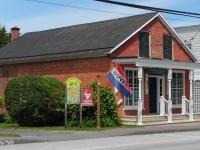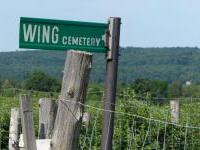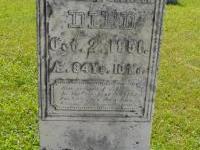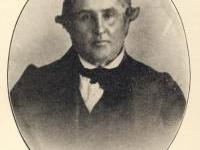As the Townships’ reputation for lawlessness spread, district officials made sporadic attempts to assert control. Local magistrate Léon Lalanne tried on several occasions to arrest counterfeiters, which resulted in personal stress, fatigue, and being “harassed six days and nights by thieves and coniackers.”
Ephraim Knight was a Bailiff for the District of Bedford. He too tried, with little success, to stop the counterfeiters and bring peace back to the community. One evening in 1818, a group of counterfeiters began carousing on the main street. As he later related the story, Knight stepped up to the crowd and commanded “peace in the name of the King,” but was “immediately robbed and clubbed unmercifully.” A similar incident occurred only a few months later when a mob assembled on a bridge and fired off guns and proclaimed that the “street was theirs and they meant to keep it.” Knight again stepped out into the fray only to have the rioters hit him with clubs and knock him into the water where they continued beating him until the citizens of Dunham came to his rescue.
Although he was unsuccessful in terms of his physical presence, Knight continued to fight the counterfeiters through his pen. In an 1835 letter to the bank in Frederick County, Maryland, he warned the cashier of a “scoundrel and a pest to society” by the name of Elijah Hurd who frequented his neighbourhood. Knight explained that it was difficult to detect the forgers “for they get their boodles and then hire someone to carry it so if they are followed and taken up, they have nothing with them”. Hurd was known to have his wife carry his money and a warning about her involvement was forwarded to the cashier as well.
 After the failed attempts to crack down on the counterfeiters, the authorities all but gave up and left the region alone. The counterfeiters’ only remaining problem was each other. In 1824, the smouldering conflict between the rival companies erupted in violence. Turner Wing led his forces through the forests armed with swords and pistols to the Paige enterprise. They attacked at dawn and carried off considerable booty including $4,000 in notes as well as people involved in the business, including Seneca Paige’s own father who had been working the presses when they arrived. The victory proved fleeting, however, since Paige and Gleason returned the favour with a raid of their own, resulting in the complete overthrow of the Wings and the return of their money, copper plates, equipment and dear old dad. An uneasy peace settled on Cogniac Street after this episode, and although Paige dominated the business, he tolerated the competition albeit diminished, from the Wings.
After the failed attempts to crack down on the counterfeiters, the authorities all but gave up and left the region alone. The counterfeiters’ only remaining problem was each other. In 1824, the smouldering conflict between the rival companies erupted in violence. Turner Wing led his forces through the forests armed with swords and pistols to the Paige enterprise. They attacked at dawn and carried off considerable booty including $4,000 in notes as well as people involved in the business, including Seneca Paige’s own father who had been working the presses when they arrived. The victory proved fleeting, however, since Paige and Gleason returned the favour with a raid of their own, resulting in the complete overthrow of the Wings and the return of their money, copper plates, equipment and dear old dad. An uneasy peace settled on Cogniac Street after this episode, and although Paige dominated the business, he tolerated the competition albeit diminished, from the Wings.
In the summer of 1833, a diverse coalition of forces gathered near Cogniac Street in preparation for what officials hoped would be the final assault on the counterfeiters. Sheriffs, constables and magistrates from both sides of the border surrounded the properties of the Gleason and Wing families. The houses were ransacked and by day’s end, tens of thousands of dollars worth of counterfeit notes, as well as presses, moulds and chemicals for producing coins, were found.
In general, men tended to dominate the counterfeiting community. By contrast, women held a subordinate status but helped in subtle ways by hiding money or at the very least turning a blind eye to their husband’s and family members’ activities. During the search of Horace Gleason’s home in 1833, Gleason passed his wife a roll of money from his pocket. She plunged it into a large bowl of apple sauce she was making in the kitchen.
In all, thirteen counterfeiters were arrested in the raid, including Ebenezer Gleason Sr., his sons Ebenezer Jr., Willard, Horace and Samuel Gleason, and nine other persons including members of the Wing family. The prisoners were manacled and marched under guard to Montreal. By September 1833, the members of the Gleason family were found “guilty of having plates in their possession for forging” but only received prison sentences of two years.
 Interestingly, Seneca Paige himself was never convicted of a crime in Lower Canada. Although he did serve time as a young man in various prisons in the United States, in Missisquoi County he actually represented his community as a Member of Legislative Assembly of the Province of Canada from 1851 to 1853!
Interestingly, Seneca Paige himself was never convicted of a crime in Lower Canada. Although he did serve time as a young man in various prisons in the United States, in Missisquoi County he actually represented his community as a Member of Legislative Assembly of the Province of Canada from 1851 to 1853!
The Missisquoi Museum in Stanbridge East holds a letter written from prison in 1834 by Benjamin Wing to Ephraim Knight. In the letter, Wing asked Knight for help in getting him released from jail. “I take my pen to write a few lines to you to let you know that his Excellency does not see fit to set me free. I received my answer yesterday which causes me to feel very downhearted […] I was very much disappointed, I felt sure that I should go out. I suppose I must give up all hopes of quitting out till my time is expired. There is no doubt but Mr. Ogden Esquire has put a stop it and I do believe he has been paid by the folks from the United States to keep the bale of us here till the time is expired.” Wing hoped that Knight would take a petition to the courts asking for an early release. He would not be able to pay Knight however as his money was “in another man’s hands.” It is not known if Knight responded to the letter or assisted Wing, but one would assume that Knight would not have helped the convicted counterfeiter, especially if he suspected him of having been one of his former attackers on the Dunham road.
The 1833 raid crippled Cogniac Street and dealt it a blow from which it never fully recovered. The worst blow, however, came when urban dealers and wholesalers in the U.S. began to commission work closer to home. By the 1850s, counterfeiting was an urban industry and Cogniac Street’s fame faded and passed out of knowledge.
 As Cogniac Street lost its hold on the market, tranquility returned to the hills and streets of Dunham. Today in the quiet cemeteries located along the old road of scoundrels, ne’er-do-wells, thieves, kidnappers and unruly mobs; weathered gravestones still record the names of counterfeiters but reveal little else about the notorious villains that lie beneath the ground.
As Cogniac Street lost its hold on the market, tranquility returned to the hills and streets of Dunham. Today in the quiet cemeteries located along the old road of scoundrels, ne’er-do-wells, thieves, kidnappers and unruly mobs; weathered gravestones still record the names of counterfeiters but reveal little else about the notorious villains that lie beneath the ground.
Turner Wing and his family are now at rest in the Wing Cemetery, amidst the bucolic setting of an apple orchard; Horace Gleason and his dutiful wife are at peace in the Dunham East Cemetery, a shady graveyard halfway along the old road; and old Ebenezer Gleason’s headstone leans gently to one side in the Harvey Cemetery.
References:
Correspondence and Papers of Ephraim Knight, Missisquoi Historical Society Collections; Jacob Ruiter Papers quoted in “They Made American Money in Canada,, McDonald Farm Journal, 1962; Philip Ruiter Ledger 1808-1836, Courtesy of Phyllis Montgomery and Robert Galbraith; Stephen Mihm, A Nation of Counterfeiters, 2007; Brian Young, “The Business of Law in Missisquoi and the District of Bedford”, in Proceedings of the Missisquoi Historical Society, Vol. 20; Oral history notations by Ruby G. Moore, Missisquoi Historical Society Collections; Heather Darch, “Losing Ground,” in Quebec Heritage News, March-April, 2008; Jimmy W. Manson, The Loyal Americans of New England and New York, Founders of the Townships of Lower Canada, 2001;. Charles Gore’s “Plan of the Frontier of Canada-East,” 1839 map; Reverend Charles James Stewart, “A Short View of the Present State of the Eastern Townships in the Province of Lower Canada,” 1815; The Reverend Charles Caleb Cotton papers, 1804-1848, Missisquoi Historical Society Collections.
